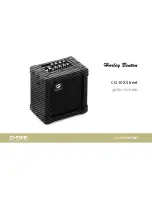
10
This recommendation results from the mathematics of bridged mono operation. In the mono
mode each amplifier channel functions for only the positive or negative half of the audio
waveform. As a result, each channel “sees” only half of the speaker’s rated impedance.
Use of an 8
Ω
speaker results in a load impedance of only 4
Ω
per channel.
Use of a 4
Ω
speaker results in a load impedance of only 2
Ω
per channel and is not recommended.
Rear Panel Bridged Mono Switch
Set the Bridging Switch to its Bridged Mono (right) position for each channel pair you wish
to bridge. The power should be off before moving this switch.
Stereo output will be weak and distorted if you accidentally leave the Mono Bridge switch
in its Bridged Mono position and you try to connect speakers in the stereo mode.
Example 4: Configuring a channel pair to operate in the Bridged Mono operation.
1. Set both Input Assignment Switches of the channel pair to Local.
2. Set the Impedance Select Switch for the channel pair 4
Ω
.
3. Connect the left output of the system controller to the even number (Ch 2, Ch 4, Ch 6, etc.)
input jack of the channel pair.
4. Connect the positive lead of the speaker cable to the red even number channel (Ch 2, Ch
4, Ch 6, etc.) speaker terminal of the bridged channel pair.
5. Connect the negative lead of the speaker cable to the red odd number channel (Ch 1, Ch
3, Ch 5, etc.) speaker terminal of the bridged channel pair.
6. Use the even number channel Level control to adjust the bridged channel pair gain.
Remote Enable Function
The remote enable feature lets a system controller totally activate and deactivate the six
channel pairs of the Z-12 (Ch 1-2, Ch 3-4, Ch 5-6, Ch 7-8, Ch 9-10, and Ch 11-12).
To use this feature, plug a wire with a 1/8” (3.5 mm) 2 channel mini plug into the Remote
Enable Jack for the channel pair you want to activate independently. Connect the other end
of the wire to the relay module that will activate the channel pair of the Z-12. Refer to the
controller manufacturer for proper use and termination required for the relay module.
Important Notes:
1. The Remote Enable jacks do not require or accept a 12 V trigger voltage, unlike the main
Auto On 12 V trigger jack. All that is required is to make a “dry contact” between the two
wires that are attached to the plug which inserts into the Remote Enable Jack to activate
that channel pair.
2. If you insert a plug into the Remote Enable jack, that channel pair cannot function until
its wires are connected to each other by the system controller.


































